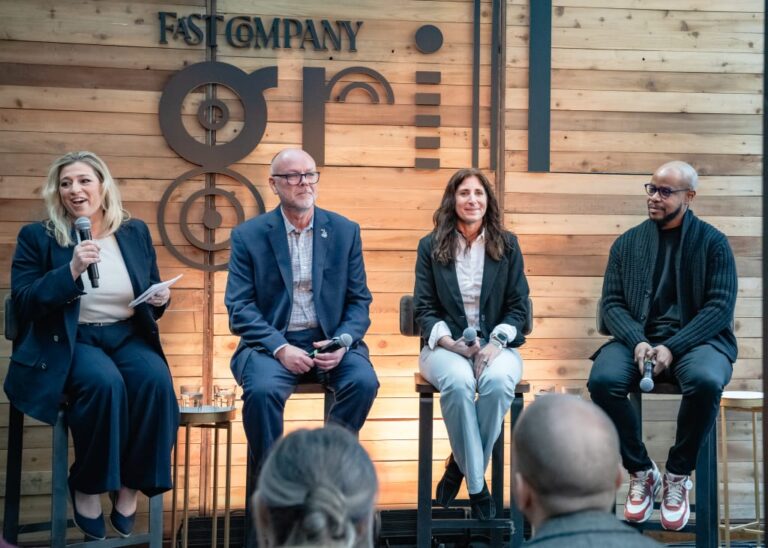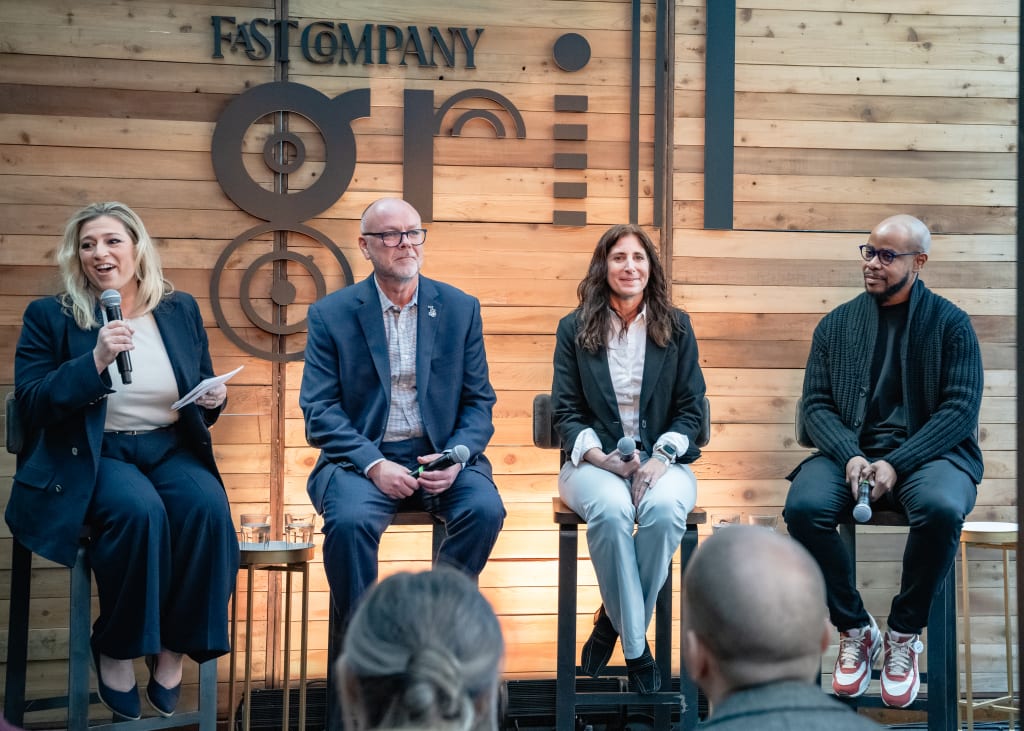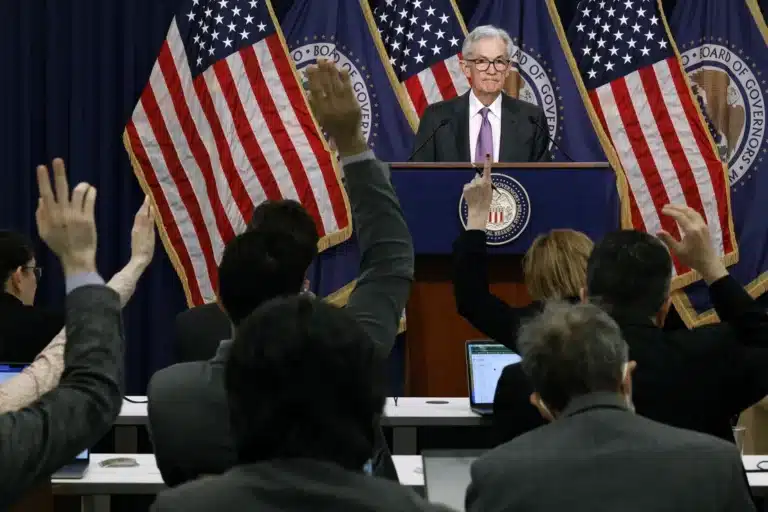Business
In the Era of AI, Trust Is the Essence of Business – SAP News
As a business leader, basing business decisions on a new technology model like cloud computing or implementing a new technology like generative AI places a premium on trust.
Paul Saunders, head of Product Strategy and chief evangelist of Cloud ERP for SAP S/4HANA put it this way during a recent interview: “Trust is not the engine oil, it’s the essence of business.”
Click the button below to load the content from YouTube.
In the interview, Saunders explains this and other aspects of the changing relationship between humans. The former Gartner analyst believes that this changed relationship has pushed trust to the top of the corporate agenda and made SAP’s commitment to relevant, reliable, and responsible business AI all the more crucial.
“The relationship between SAP and our customers for the longest time was transactional,” he says. But the shift to the cloud has changed that. From the customer’s perspective, in a cloud environment the SaaS vendor is effectively running the business and that requires a whole new level of trust.
As Saunders notes, “When a data center goes down the customer can’t just say, ‘Hey Bob, get down to the computer room and reboot the box.’ Now, with AI, it’s not just the data we’re providing, but information and recommendations. And some of those recommendations might challenge what the person thinks intuitively.”
For example, when Saunders was CIO of a golf cart maker in Georgia that shipped the carts all over the United States, he put in an early AI-based route planning package designed to optimize the deliveries of the carts to customers across the country.
But despite the potential efficiency gains promised by the technology, the CEO who had run the company for 40 years and was accustomed to relying on his own judgment overruled the software and insisted that the drivers follow his preferred delivery route.
This resistance to change reflects a broader reluctance to embrace data-driven decision-making, with individuals often interpreting data in a way that reinforces their existing beliefs rather than challenging them.
When faced with the suggestion from a machine to do something different, most people will only follow the advice if they have solid confidence in the accuracy of the underlying data and can retain oversight of the process.
Build AI directly into your core business processes with SAP Business AI
That, according to Saunders, plays to SAP’s advantage. He acknowledges that SAP is sometimes considered to be “a little bit old fashioned,” but also thought of as “incredibly reliable and trustworthy.”
In such a fast-changing and unpredictable environment — one in which many experts, including Saunders, predict that at least one big brand name company will be in the news “for doing something terrible with AI” — SAP’s commitment to delivering dependable solutions infused with relevant, reliable, and responsible business AI is key.
For Saunders, the importance of fostering trust and confidence in both the technology itself and the organizations deploying it, particularly in industries where risk aversion and conservatism are prevalent, cannot be overstated.
But he also believes that organizations need to strike a balance between automation and human intervention, recognizing that while AI can streamline processes and improve efficiency, human judgment and oversight remain essential for ensuring the accuracy and reliability of AI-generated insights.
In the end, what really matters to customers is not the technology itself, but the business value that it creates. “If you go to any CEO or CFO, they will tell you they only care about three things: revenue, cost, and risk. That’s it.”
Ultimately, he says, “Everything we do has to show the business value.”
Subscribe to get the latest news from the SAP delivered to your inbox weekly
Investors Are Showering AI Startups With Cash. One Problem: They Don’t Have Much of a Business – The Wall Street Journal
Investors Are Showering AI Startups With Cash. One Problem: They Don’t Have Much of a Business The Wall Street Journal
It’s National Small Business Week – WSFA
At Gray, our journalists report, write, edit and produce the news content that informs the communities we serve. Click here to learn more about our approach to artificial intelligence.
Partnership On AI CEO On The Best Way To Bring AI To Business – Forbes
The Partnership on AI is a nonprofit organization dedicated to ensuring AI developments advance positive outcomes. CEO Rebecca Finlay has a wide perspective on how businesses are bringing AI into their operations, what they plan to do with it and what’s likely to happen next. I talked to her about business AI implementation and how to get the benefits from this high tech platform.
This conversation has been edited for continuity, brevity and clarity. An excerpt appeared in Sunday’s Forbes CEO newsletter.
It’s been roughly a year and a half since ChatGPT made AI something everybody is talking about all of the time. Where are CEOs now, in terms of their conversation about AI and understanding of its power?
Finlay: CEOs are trying to determine if it sounds as good as it seems to be. With AI and the way in which AI is developed, and certainly we’ve seen this with ChatGPT, is that it has the potential to be truly transformative. We see in survey after survey with CEOs that they expect that there will be significant change, both within their companies but within the sectors they operate in, over the next five years with regard to both AI and generative AI technologies in their companies. They’re in a moment where they are trying to assess. What are the benefits? What is the return on the investment of this technology in terms of our business goals: better products, better services, better relationship with our clients and customers? And what are the risks, and that’s all the way from privacy concerns around the use of data that trains these models through to the accuracy of some of these generative AI models, through to other impacts both on their workforce potentially with the use of synthetic media or other forms of malicious acts.
I see CEOs really attending to the reality that most companies these days are AI companies in some way, shape or form, and really trying to understand: Okay, what are the problems I need to solve where I have both the data and an AI system, and the inferences that come out of it are actually going to be useful for driving my business forward. And we’re seeing that in all sorts of different applications.
Partnership On AI CEO Rebecca Finlay.
Partnership On AI
In general, how are companies doing with identifying where AI can work for them? Are they honing in on the best places to use it? Or is there more of an interest in what looks interesting, but might not be the best place to start?
What I’m hearing is the desire to start iterating and piloting and testing some different systems on some different problems with some different datasets in order to derive some different benefits. And this is certainly what I recommend. I think if a company is looking at an AI system as a driver in the first and foremost of efficiency, that needs to be weighed together with all of the potential risks that come therein, and particularly with regard to deploying it into their workforce. I urge two things: One, that you have in place a structure within the company that allows for you to be thinking about the cross-departmental impact of AI. Maybe like a chief data analytics officer or chief AI officer. A council, a group that is coming together that definitely includes IT, but also includes people from your legal teams and otherwise, that are really trying to explore how do we understand and test out this technology in order to be able to see how we can benefit from it. And then, what are the tools we need that will actually help us to both be innovative and responsible at the same time?
Ultimately, that all comes down to people. It all comes down to the capacity to have the right people on your leadership team, or giving you the honest assessment of the possibility. It also means a good relationship with your board of directors, so that you’re making sure that they have some visibility from a risk management perspective into how AI is being deployed in your company. And it also means having really good disclosure requirements with the public and with your customers and clients as well, in terms of how their data may be used or how you might be using systems. That also stretches to your partners, both your suppliers and those partners that are further down the value chain, understanding what you are receiving from them that may have been built with different data, and the efficiency, capabilities and responsibilities of those models as well.
What do you see as an ideal way a business can assess the way to go about using AI?
For me, an ideal assessment is one that doesn’t prefer innovation and speed over responsibility. I say that the reason why we can drive fast is because we have brakes in our cars. The reason why we can drive fast and be safe is because we have seatbelts, right? Those are two innovations that are safety innovations, that actually drive our capacity to move more quickly and more effectively and more safely down the road. And so I encourage companies to get started because there are all sorts of ways in which AI could be helping them to serve their customers better. I also say if you’re going to get started, make sure that you are considering the responsibility requirements right from the very start. Then you’re building, I think, a much more effective system that’s going to drive much more effective product down the road as well.
What kind of people in a company should have a voice in AI decisions to make sure that layer of responsibility is there?
Making sure that you have a council of advisors who [meet] regularly. I think the council can do a couple of things. One thing: It can be monitoring developments in the broader sector and perform a learning and educational role. It can also be providing space to do some of this piloting. And then once systems are deployed, it can also be doing some work to monitor post deployment, right? The thing about these AI systems is that they can be trained in one set of data, but once they’re out in the wild, they need to be monitored as well to make sure that they’re continuing to do what you want them to do. That, I think, is really important.
The other piece that is really essential is that if you are deploying automated systems into your workforce. Let’s say you have a call center and you’re going to use a chatbot in that call center, it is really important that the workers who are in that call center be part of that technology deployment. First, because they know what they need. They know where the gaps are—where a system that’s giving them, for example, the ability to answer questions much more quickly or in different languages, they’ll know what they need from that. And then secondly, what all of the research today has shown about these systems is that they actually can drive worker well-being and better productivity if they are deployed in partnership with the workforce that’s actually using them as well.
When CEOs are looking at AI right now, do they seem to have a handle on kind of everything it takes? Are they aware of the responsibility, safety and security issues, whether they need to hire more people, if more training is needed for existing employees?
It’s a question of, do you have the right people with the right skill sets? It used to be, and it continues to be, very important that you have very strong IT expertise, computer science and computer engineering expertise in house. But what we’re seeing with some of these generative AI models is their capacity to code, and their capacity to be able to pick up some of that coding work that some of your software engineers may have been doing previously, and that might create space for them to do some of the innovations that we’re talking about around AI.
But also, I think it is understanding from your privacy professionals and your legal advisors internally, as well as your product and marketing professionals. What are they each hearing in their own professional associations? We’re seeing a lot of interest from lawyers’ associations to better understand what the legal issues are. And one of the key pieces there, of course, for both your lawyers and your privacy officials and others, is the evolving policy landscape. We now have the EU AI Act, so if you’re a company that is in the EU market, understanding what the implications are for you therein is really crucially important. And then we have a number of states in the U.S. who are developing different state-level privacy bills. So really, you need to have a community that’s both attending to what’s happening in-house, but also really understanding from their professional perspective what some of the emerging trends and opportunities might be.
And then, of course, you have organizations like the Partnership on AI, which is really a learning community coming together to explore some of those topics in real time. One of the reasons why many of the companies become our partners is they not only believe in our mission: That we want to develop responsible and safe AI that benefits the many, not a few. But also, they’re learning a lot from being right there, developing some of these risk management frameworks, transparency requirements, worker integration guidelines. These are all things that we’re working on right now. That’s probably one of the most interesting things about AI: It’s still very much a young field, and there aren’t a lot of clear frameworks to go to to better understand how to manage risk and how to do that in real time to attend to innovation.
When CEOs are looking at AI and talking to their finance team, where is the priority? Are they looking for a quick return on investment? Is it eventually saving money? Or is it all about keeping up with other companies?
CEOs are dealing with these demands across their business sectors, no matter whether it’s AI or otherwise. There’s always this tension between speed, pace of change, need to innovate for efficiency and productivity; together with what is my competition doing, and how do I make sure that I’m in a competitive place to move forward. And then the other piece of it is the risk; the unknown pieces of this model. I think that CEOs are in this moment, weighing all of those. Getting the good team in place internally to give them some advice, trying to engage as much as they can with experts outside of their companies who can help to give them some of that advice as well. And I think, most importantly with the board, is coming to a clear understanding about what level of transparency the board needs in order to be assured that the AI decisions that are taking place are being done transparently and responsibly.
One of the interesting developments that I’ve noticed, some [publicly traded] companies have started within those [annual financial] filings that specifically speaks to what are the risks: We’re using AI. What are the risks that we want to make sure that the public is aware of? That, to me, is a really interesting form of governance that really shows how important it is for companies to be attending to the innovation components of AI, and doing it in as transparent a way as possible.
At the beginning of the interview, we started off by saying it’s been about a year and a half since ChatGPT started the big movement toward AI. Where do you think businesses will be with AI a year and a half from now?
In a year and a half, I expect that a number of companies will be moving from the piloting and iterating and exploration stage into the deployment stage. Of course, there are many companies that are already using AI machine learning in all sorts of very low-risk ways across their portfolio of work.
Every company is an AI company, is a data company. We’re going to start to see it really integrated across a number of different areas, and particularly when it comes to generative AI. First of all, the generative AI models are progressing. They are getting better. They are getting more accurate. There’s been this loosely used term of hallucinating, but the reality is that some of these models are giving you inaccurate information. So there’s all sorts of technology development underway to think about how that could be improved.
That will be very interesting because we’ll start to see generative AI applied in some really interesting ways. We could see it applied, for example in a marketing department, where you need to be doing some creative thinking about how you are positioning your messaging, and how you are developing your materials. You could see that there may be ways in which it could really drive a whole level of product development. Or we could see it in R&D that could allow companies to do some modeling and scenario planning using synthetic models, potentially like a manufacturing center would develop them.
I think in 18 months time, we’re just going to hear that that has moved forward in a way that we haven’t yet seen to date, and I think that’s what’s going to be really exciting. My recommendation is if you’re a CEO and in 18 months you really want to be thinking about having some applications of AI and generative AI that are really driving value for the organization, get started. Get started by putting the people in place, by putting the resources and tools in place. We like to say document everything. It helps you internally to know better, and will help you provide some oversight externally to your board about the work you’re doing. And get your people engaged in the conversation. So if that means upskilling your workforce, or creating ways for them to get engaged and creatively rolling it all together.
Any final thoughts?
As a species, we’re not particularly good at predicting the future. So I strongly encourage business leaders to keep an open mind about this technology and how it can truly advance and transform the work that they’re doing, through the lens of wanting to serve their customers and clients better. Each company has deep knowledge of what its customers need. It may be that generative AI isn’t the right thing to meet their needs. It may be that there are other forms of AI that will help you to do things better.
It’s a really exciting and innovative and uncertain time for CEOs to be thinking: Okay, how do I, and how do[es] my company, and how does my board want to be really ensuring that we make the decision that’s right for us, that’s going to drive the benefits that we know we need moving forward?

How CEOs are preparing for possible employee protests – CNN
A version of this story first appeared in CNN Business’ Before the Bell newsletter. Not a subscriber? You can sign up right here. You can listen to an audio version of the newsletter by clicking the same link.
New York
CNN
—
Google CEO Sundar Pichai recently fired about 50 employees for protesting the company’s relationship with the Israeli government. His explanation boiled down to four words: This is a business.
Some people disagreed with his actions, including the group that organized the protest.
“Google is throwing a tantrum because the company’s executives are embarrassed about the strength workers showed at last Tuesday’s historic sit-ins, as well as their botched response to them,” the No Tech for Apartheid group said in a statement.
As workers around the country see protests against the Israel-Hamas war and encampments proliferate on college campuses, they might wonder if these actions could start to spread to offices as well.
Before the Bell spoke with Johnny C. Taylor Jr., president and CEO of trade association SHRM, previously known as the Society for Human Resource Management, about how companies are preparing for potential protests among employees and how workers should express opposing views at the office and beyond.
This interview has been edited for length and clarity.
Do you think Google’s actions were justified? Should employees be allowed to protest at their place of work?
I fundamentally, 1,000%, agree with Sundar Pichai.
Companies often offer forums where you can share your thoughts, because they want to welcome a diverse perspective. That’s a good place for an employee to share their feelings. You can’t share your feelings by blocking entrances to work, that’s not okay. Taking over the president of a division’s office, not okay. We are ultimately here, as organizations, to run a business. Anything that disrupts the running of that business is not okay.
We hire people and encourage people to have diverse opinions about these things. We don’t want a monolithic workforce, and we’re not judging who’s right or wrong. We’re just saying you can’t disrupt work.
Should employees be worried about protesting outside of the workplace?
It depends. You shouldn’t engage in anything that compromises a company’s reputation, even outside of working hours. You have to be really careful there, it’s your time and you have a right to protest and to have a point of view. But if that in any way does not reflect your company’s culture or values or (causes) disrepute to their brand, they have a right to fire you. You can always choose to move on, but remember you don’t have a right to work at most companies.
How should corporate leadership work with or address rising tensions in the workplace?
Good leadership says, ‘we respect your differences and we embrace them.’ Diversity is something they should be committed to. They should say that we can disagree, but we’ve got to disagree better.
Good leadership is CEOs convening their employees and telling them they can talk about their perspectives but that yelling at, shaming or embarrassing colleagues is always unacceptable behavior and a behavioral offense. More and more CEOs are laying this out, we have reached that point. Practicing incivility is not something they’re going to tolerate.
I’m actually pleased about that. Because I think we overcorrected, we actually did. Wanting people to bring their full selves to work is great, but what we have found is people want diversity, as long as they agree with it.
You’d be surprised about how many people want to come to work just to work. They’re not interested in debating social issues at work.
Should the leadership at companies being called out by protesters respond?
Generally you ignore it. Every day, there will be some group of employees who don’t agree with who you do business with, who does business with you, etc. Just by definition, a CEO could find him or herself every day having to address every one of their client relationships. We establish upfront, the head of HR and the CEO, what our values are and how we’re going to operate. You have to make that clear to employees, we call it cultural clarity. And then employees can self-select — they don’t have to work there.
But there are some issues that are worth addressing and we clearly don’t want to suppress employees or stop them from sharing with us. I think it comes down to three words: challenge, decide, commit.
If you think we should not do business with whomever, then challenge it. I want to hear from my employees as the CEO, and so I give permission to challenge our practices. Based upon that, I will respond and then you have to decide. And after you decide, you must commit. And there are off-ramps for employees if they don’t like the decision.
So, generally, we encourage CEOs to want to be challenged to think differently. But they need to be challenged respectfully and civilly. But once a decision is made, that’s it. We can’t keep re-litigating when we also have a business to run
You speak with CEOs every day. Are they worried about employee protests?
Yes. Most of the CEOs I’ve talked to said they haven’t seen their employees protest, but they’re bracing for it. They don’t think this will be isolated to Google. But I will say that I don’t think it will become that widespread because of how swiftly and unapologetically Google addressed it. I don’t think it will become a thing.
I think Google’s response has given a lot of cover to other companies, but I’m hearing a lot of management teams put plans into place just in case.
Rolls-Royce is vastly expanding its factory in Chichester, England. The BMW subsidiary is adding five new buildings with construction planned to start next year, reports my colleague Peter Valdes-Dapena.
Usually, when a carmaker expands a factory it’s for one simple reason: building more cars. But this is Rolls-Royce. Making and selling more Rolls-Royces would undermine the brand’s vaunted exclusivity.
So this factory expansion isn’t about making more cars, but making more expensive cars, which takes more time and requires more space for workshops and storage of exotic materials.
The expansion signals something about Rolls-Royce’s ultra-wealthy clientele. While they can only buy so many cars, they can certainly spend more on each one.
Since 2020, Rolls-Royce sales have increased 17%, reaching a record of 6,032 cars and SUVs worldwide last year. Over that same time, though, the average amount of money customers paid for their cars increased 43%, going from $350,000 in 2020 to $500,000 each, on average, last year.
That increased revenue per vehicle comes largely from more complex and time-consuming customization — “bespoke,” as Rolls-Royce terms it — requests. It even calls its luxury customization programs “Bespoke” and, for fully customized models, “Coachbuild.”
“We’re not necessarily growing that much in volume,” said Martin Fritsches, president of Rolls-Royce Motor Cars Americas. “That’s obviously not our focus point. But clearly, our bespoke area is gaining and relevant. And has been expanding dramatically, particularly in the last couple of years.”
CEOs of OpenAI, Google and Microsoft to join other tech leaders on federal AI safety panel
The US government has asked leading artificial intelligence companies for advice on how to use the technology they are creating to defend airlines, utilities and other critical infrastructure, particularly from AI-powered attacks, report my colleagues Brian Fung and Sean Lyngaas.
The Department of Homeland Security said Friday that the panel it’s creating will include CEOs from some of the world’s largest companies and industries.
The list includes Google chief executive Sundar Pichai, Microsoft chief executive Satya Nadella and OpenAI chief executive Sam Altman, but also the head of defense contractors such as Northrop Grumman and air carrier Delta Air Lines.
The move reflects the US government’s close collaboration with the private sector as it scrambles to address both the risks and benefits of AI in the absence of a targeted national AI law.
The collection of experts will make recommendations to telecommunications companies, pipeline operators, electric utilities and other sectors about how they can “responsibly” use AI, DHS said. The group will also help prepare those sectors for “AI-related disruptions.”
“Artificial intelligence is a transformative technology that can advance our national interests in unprecedented ways,” said DHS Secretary Alejandro Mayorkas, in a release. “At the same time, it presents real risks — risks that we can mitigate by adopting best practices and taking other studied, concrete actions.”
Among the panel’s other participants are the CEOs of technology providers such as Amazon Web Services, IBM and Cisco; chipmakers such as AMD; AI model developers such as Anthropic; and civil rights groups such as the Lawyers’ Committee for Civil Rights Under Law.

Business owners celebrate successful NFL Draft – FOX 2 Detroit
The successful hosting of the NFL Draft didn’t just add momentum behind the city’s revival, but it gave local businesses a foundation to build on ahead of more events and successes coming to Detroit.
Posted

Richard Branson says this decision helped build his $2.5B net worth: ‘I don’t think I would have gone to space’ otherwise – CNBC
This story is part of CNBC Make It’s The Moment series, where highly successful people reveal the critical moment that changed the trajectory of their lives and careers, discussing what drove them to make the leap into the unknown.
Richard Branson is a thrill-seeker. He’s traveled to space in his own rocket ship and crossed oceans in a hot air balloon.
So if you ask him for one of the hardest decisions he’s ever had to make, you might get a surprising answer: a moment when he opted to "play it safe."
He’s referring to selling record label Virgin Records to Thorn EMI for nearly $1 billion in 1992. The deal made sense from a business perspective but the idea of selling one of his first ventures — one that started as a brick-and-mortar record shop in London in 1971 — left him in tears, he says.
"It was definitely a sad day," Branson tells CNBC Make It. "I remember running down the street with tears streaming down my face, past a sign that said, ‘Richard sells for a billion.’"
Branson needed the money to focus on a newer venture, Virgin Atlantic. The upstart airline needed resources for a legal battle — one it eventually won, as he details in his new audiobook memoir, "Losing and Finding My Virginity" — over an alleged smear campaign perpetrated by British Airways.
He had two choices: Sell his record label or risk the failure of his airline. Emotionally, selling Virgin Records was like casting away a piece of himself, says Branson — but it was established and successful enough to keep thriving under new ownership.
Meanwhile, Virgin Atlantic’s failure would’ve marred his reputation and threatened the expansion of his business empire, which today ranges from telecommunications to spaceflight. Virgin Group is largely responsible for Branson’s estimated net worth of $2.5 billion, according to Forbes.
The billionaire’s fondness for Virgin Records still endures: He reportedly considered buying the brand back as recently as 2012, though a deal didn’t come to fruition.
Here, Branson discusses the difficulty of letting go of one beloved venture to boost another, how that decision helped shape the future of Virgin Group and why you should balance instinct with caution when seizing any big opportunity.
CNBC Make It: How did you make the decision to sell Virgin Records? What was going through your head?
Branson: Virgin Records was the biggest independent record company in the world. We’d just signed The Rolling Stones and Janet Jackson. It was going unbelievably well.
Virgin Atlantic was a child at school who was being bullied. I had to really turn my attention to the child that was being bullied. What I decided was: If I sold Virgin Records, all the people’s jobs would be secure. I could then use that money to build and protect Virgin Atlantic.
Richard Branson publicizes the sale of Virgin Records to Thorn EMI in June 1992, London, England.
Richard Baker | In Pictures | Getty Images
Sadly, sometimes in life, you’ve got to make tough decisions. That was the right decision to make at the time.
Of course, the record industry then went through turmoil, and everybody thought we’d been very clever. Now, I hear our music playing everywhere — it’s come back with a vengeance — but at the time, it was the right thing to do, difficult though it was.
Did you consider trying to keep both, or would that have caused Virgin Atlantic to fail?
I don’t think we’ll ever know, to be honest. Obviously, it would have been lovely to have kept both, and we may well have survived by keeping both.
But on occasions, you’ve just got to play it safe — and I don’t normally play it safe.
I just felt that I needed to protect the downside, [which] was seeing a new child, Virgin Atlantic, disappearing. And I wasn’t going to let British Airways beat us.
So, is it fair to say the Virgin Group would look very different today if you hadn’t made that decision?
Yes. With the resources from the [sale of the] record company, we moved into trains, mobile phones, cruise companies and fitness clubs. There were literally tens of thousands of jobs created using the resources from the record company.
I don’t think I would have gone to space on my own spaceship if I hadn’t made that decision.
I’m not complaining about any decision I’ve made in the past. I think we’ve been fortunate. Every year of my life has been a roller-coaster ride. That’s been rewarding and fascinating.
How do you weigh emotion against money when making a business decision? Do you struggle with those decisions today, when you sell or spin off other Virgin brands?
I think that when people sell their company, they can sometimes feel slightly empty. It’s important to know what they want to do, having sold it. It’s important that they’ve got something else to get their teeth into, either socially or business-wise, because there can be quite an empty feeling for people, even despite having money in their bank account.
What we love doing is creating things. We will always keep 100% of the top company, the Virgin Group. Then we have subsidiary companies, some of which we’ve floated, some of which we’ve kept private, some of which we may have sold quite a lot of.
That means I can still do bold things, like going into space or starting a cruise line. By having the subsidiary companies, we can bring in other shareholders and this money comes up to the top to enable us to still be entrepreneurial.
When you make a risky decision, how do you prepare for both your best-case and worst-case scenarios?
Protecting the downside is very important. [Launching] Virgin Atlantic 40 years ago is a very good example.
I had an instinct that if we created the best-quality airline flying across the Atlantic, it would survive. I knew it was very risky. I personally have said that the best way of becoming a millionaire is to start off as a billionaire, and go into the airline industry.
So in case my instinct was wrong, I negotiated the right to hand [Virgin’s first plane] back to Boeing at the end of the first year. The most the airline was actually going to cost — apart from my reputation, which is obviously very important — was roughly a year’s profits at Virgin Records.
This interview has been edited and condensed for clarity.
Want to make extra money outside of your day job? Sign up for CNBC’s new online course How to Earn Passive Income Online to learn about common passive income streams, tips to get started and real-life success stories.

Why civility at work is good—and good for business – Fast Company

Incivility is on the rise, fueled by factors such as widening political divides and less-than-social behavior on social media platforms. While uncivil behavior takes an emotional toll on people, it’s also bad for business. Recent data shows that nearly two-thirds of workers have experienced incivility in the past month and that such conduct between employees hinders productivity and ultimately hurts a company’s bottom line.
SHRM is an organization whose mission is to create better workplaces where people and business thrive together. It believes that civility is a cornerstone of workplace culture and is essential to fostering inclusion and innovation. But promoting civility requires intentional action. Fast Company, in partnership with SHRM, teamed up during SXSW for a panel discussion on how leaders can create an environment where employees feel valued, respected, and empowered to be their authentic selves and deliver their best work. Here are four takeaways from that conversation. (Scroll to the bottom to watch the entire panel discussion.)
1. Practice active listening.
Promoting civility in the workplace starts with a willingness to communicate openly with each other, said Jim Link, chief human resources officer at SHRM. Active listening—the practice of listening to a person’s words while tuning into their body language to understand the emotion behind their words—can help make workplace communications more effective and meaningful.
An active listener considers another person’s point of view, as well as their emotional state, before responding and taking thoughtful action. This will help them to feel understood and valued. “If you are actively engaged in dialogue with other people—regardless of whether or not you agree—you’re giving them the capability to be heard,” Link said. “And all of us, at some point in our lives, just want to be heard.”
2. Foster connection, trust, and psychological safety.
People are more likely to react in annoyance or anger when they don’t feel seen or heard. Managers can mitigate this problem by fostering safe places for employees to voice concerns and speak about topics that are important to them.
For example, workplaces can offer employees a dedicated channel on a messaging app or digital platform to share their thoughts on controversial issues or polarizing topics. Mentorship programs can also help forge positive relationships between managers and employees, giving workers an outlet to discuss challenges and develop tools to address them.
But connection is just the first step. Trust among colleagues is a key component of a healthy workplace culture, as well. “When you don’t trust that someone has your best interest at heart, you don’t feel psychologically safe,” said Beric Alleyne, global head of diversity, equity, and inclusion at eBay. “So, you’re more likely to hide behind digital media or do the insensitive actions that potentially lead you down a wrong path.”
Build trust by offering programs such as cross-cultural learning, which enhances sensitivity and communication, and immersive educational opportunities that allow employees to practice having hard conversations.
3. Learn to press pause.
In difficult situations, it’s common for people to react before fully considering the best way of handling the situation. “Sometimes we just jump in, full steam ahead, because we are uncomfortable,” said Jenn Saavedra, chief human resources officer at Dell Technologies. Pressing pause can help people take a deep breath, collect themselves, and avoid reactive responses.
Taking a beat can also help temper other people’s reactions. When faced with an uncomfortable confrontation or conversation, try letting the other person finish speaking before reacting. This simple act can help diffuse tension right off the bat. Sometimes people just need to let off steam, and listening to their concerns can help diffuse the situation. “Just by listening, you begin to see the temperature go down,” Link said. From there, both parties can respond from a calmer place.
4. Own your mistakes.
No one is perfect, and it’s especially important for leaders to acknowledge when they make mistakes. “Sometimes people get scared and they want to hide from mistakes,” Saavedra said. “But the key here is to own it. Be authentic and genuine and say, ‘I was not at my best today; I don’t feel good about our conversation; I was wrong.’”
Taking responsibility for your own mistakes helps demonstrate which behaviors leadership finds unacceptable. By modeling how to resolve conflict with respect, leaders foster a culture of compassion where mistakes can be met with empathy. “There’s a give-and-take to respect, and we know respect is a big part of civility,” Alleyne said. “If you make a mistake, own it. If somebody else makes a mistake, be forgiving.”
The panel conversation concluded, aptly, by Link reminding those in attendance of the importance of prioritizing civility at work, noting how SHRM’s “1 Million Civil Conversations” initiative begins with each of us. “The people in this room and the other million civil conversations that we’re going to have will make a difference in the world of work, for workers, and in that workplace.”
_____________________________________________________________________________________
To learn more and find resources about how you can turn discord into dialogue, visit shrm.org/civility.
_____________________________________________________________________________________
Recognize your brand’s excellence by applying to this year’s Brands That Matter Awards before the early-rate deadline, May 3.

The Fed’s preferred inflation gauge just moved in the wrong direction
Source: The Fed’s preferred inflation gauge just moved in the wrong direction CNN — Alica Wallace Inflation remained stubbornly high last










